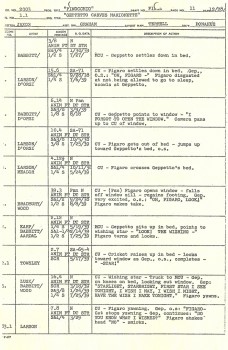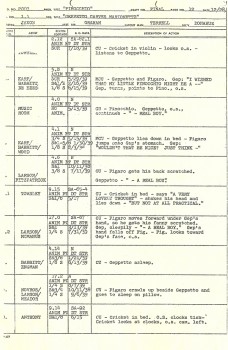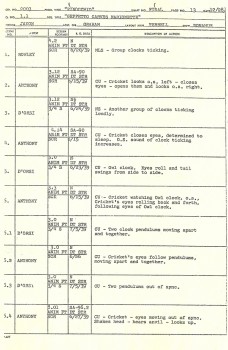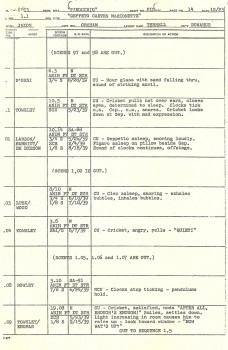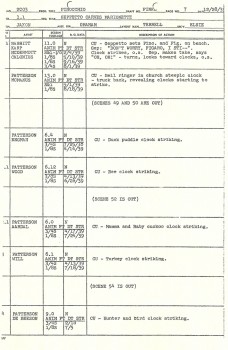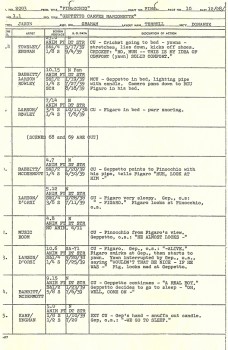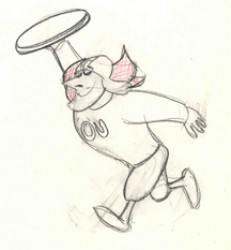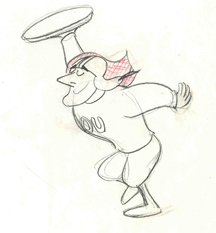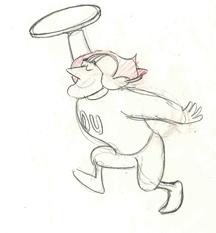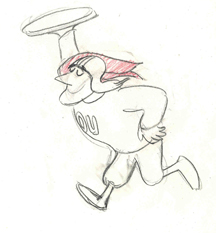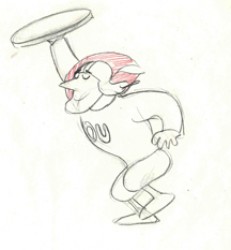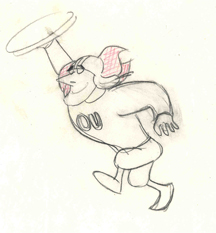Category ArchiveAnimation Artifacts
Animation Artifacts &Hubley 15 Apr 2006 07:49 am
Duncan Stork
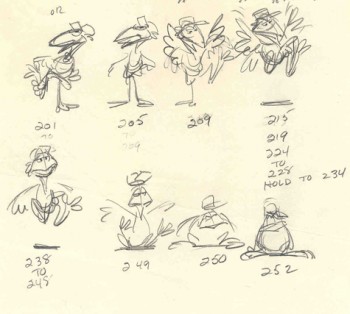 – Years ago I worked at the Hubley studio on a pair of commercials for Vlasic pickles. One of the two spots made it to the air.
– Years ago I worked at the Hubley studio on a pair of commercials for Vlasic pickles. One of the two spots made it to the air.
This is from the spot that never made it.
Vlasic had a commercial they wanted, and because of the agency’s long time relationship with the Hubleys, they came to him to try to develop the character. (The agency was W.B. Doner, the agency that had done so well with Hubley’s Maypo commercials.)
(Click on image to enlarge.)
The agency came with two already-recorded voices: one was a Groucho Marx impersonator (I’m not 100% sure, but I think it may have been Frank Gorshin); the other was character actor, Edgar Buchanan. John wanted Edgar Buchanan – it was a much richer voice, lots of cowboy appeal.
John designed the character to look like one of those stationmasters in cowboy films. The guy who gives out tickets and does morse code when he has to. The stork had a vest and a blue, boxy, stationmaster-type cap cocked off to the side. It was a great character.
Phil Duncan was the animator. A brilliant character guy who had done everything from Thumper to George of the Jungle. I loved cleaning up and inbetwwening his work. It was all fun and vibrating with life.
This pictured piece of art fell out of one of Phil’s packages. It was a thumbnail plan of the action. Phil would do these things which usually stretched around the edges of his final drawings. In a nutshell, you could see the scene and how he worked it out. Lovely stuff.
I felt this drawing was as beautiful as the original animation drawings.
Animation Artifacts &Commentary 14 Apr 2006 07:16 am
Good Friday
- The reviews for The Wild are much more positive than I would have expected given the pre-reviews. All of them mention the similarity to Madagascar, but they it gives them the chance to talk about the differences. Ice Age 2 dethroned? Here’s the NYTimes, The NY Daily News, the LATimes, Roger Ebert, and Emru Townsend.
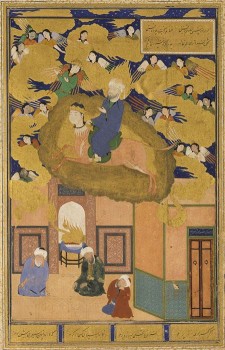 – Everyone out there interested in insightful animation should have tuned into the last two episodes of South Park. It’s an absolutely brilliant take on The Family Guy, The Simpsons, and South Park, itself. No wonder this show won a Peabody – they deserved it. This show, particularly these episodes, feature some of the best writing on television. Hilarious and insightful.
– Everyone out there interested in insightful animation should have tuned into the last two episodes of South Park. It’s an absolutely brilliant take on The Family Guy, The Simpsons, and South Park, itself. No wonder this show won a Peabody – they deserved it. This show, particularly these episodes, feature some of the best writing on television. Hilarious and insightful.
The controversy surrounding the show revolves around censorship on television. An episode of The Family Guy, which plans on showing an image of Mohammad, has all of America burying their heads in the sand to avoid facing the censorship issue. Kyle and Cartman set out to save the day in a struggle of our civil rights in the US. Bart Simpson also gets involved.
Comedy Central actually did censor the image of Mohammad from South Park, and the creators, Stone and Parker, are livid with the censorship they’ve had to face. The episode aired intact in Europe. For more about it: NYTimes, or The Telegraph.
- The following is a continuation of the production drafts for Pinocchio. Hopefully, these are of interest to enough people out there. I have to admit it doesn’t make for the most attractive visuals, but what ho.
Animation Artifacts 12 Apr 2006 07:31 am
Kimball
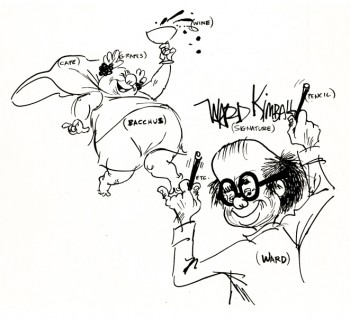 – For no good reason, I thought I’d post these beautiful drawings by Ward Kimball. I have a bunch more and will post those eventually. I’m not sure how many made it into books since I’ve had these photostats for so long that they’re very familiar to me.
– For no good reason, I thought I’d post these beautiful drawings by Ward Kimball. I have a bunch more and will post those eventually. I’m not sure how many made it into books since I’ve had these photostats for so long that they’re very familiar to me.
It’s great to see this quality of draftsmanship in animation; Kimball had an original style on top of his amazing ability to draw. This, of course, doesn’t even mention the fact that he was a brilliant animator with a unique animation style.
(Click on images to enlarge.)
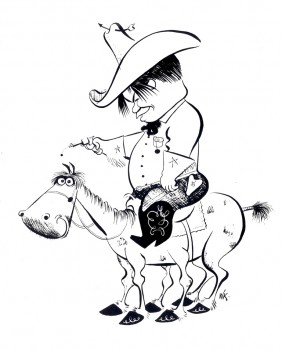 Now, no one needs me to give my thoughts on Kimball’s work, but I think it is valuable to be reminded of his brilliance.
Now, no one needs me to give my thoughts on Kimball’s work, but I think it is valuable to be reminded of his brilliance.
If we only had the crow dance in Dumbo, or Jiminy Cricket in Pinocchio we would have had to classify him as a master. Take a look the Mad Hatter in Alice in Wonderland or his direction on Toot Whistle Plunk and Boom, and you have proof positive. His Tomorrowland episodes for the Disneyland TV show (“Man in Space,” “Man and the Moon”, “Mars and Beyond” or “Our Friend the Atom”) were intelligent attempts to explain science of the day.
There are some pieces he did that I out and out don’t like (Bacchus in Fantasia or It’s Tough To Be A Bird), but I’ll say that those are just not my taste – too overdone, too broad, too cute. However, Kimball was something of a genius who stood out from the others at Disney. Just l0oking at his drawings make you smile; they’re so smooth.
Note: Thanks and regards to John Canemaker who reminded me that he gave me these drawings/photostats. The first appears in his Nine Old Men book and is just a small part of what makes that book such a gem.
Animation Artifacts &Commentary 03 Apr 2006 07:16 am
2 Beauties
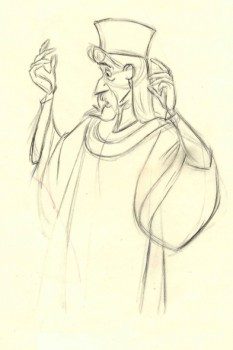 – My favorite site in the last week has definitely been Amid Amidi’s Cartoon Modern. He has been posting a lot of models from Rooty Toot Toot which are just amazing.
– My favorite site in the last week has definitely been Amid Amidi’s Cartoon Modern. He has been posting a lot of models from Rooty Toot Toot which are just amazing.
Then to break from that film, he gave us Eyvind Earle Bg models for Sleeping Beauty. The artwork posted has been beyond inspirational, and the comments given to Amid are also strong. I hadn’t realized how many people didn’t like Sleeping Beauty. I’d always thought Earle’s Bg styling and Tom Oreb’s angular characters were a perfect match. Since half of the design of tv animation and movies like Pocahontas have ripped into Eyvind Earle’s work, it interests me to see how many people blame him for the film’s failure – if there is one.
The site has provoked argument and information. It’s extraordinary always to see how other people think and feel about these classic films. I love reading it all, and the artwork is sensational. Kudos Amid. This site has become a must visit, daily.
Animation Artifacts 30 Mar 2006 08:10 am
Gepetto goes to sleep
 - Here are four more pages of the production scene drafts for Pinocchio. It takes us to the point where Gepetto turns out the light, and the small family goes to sleep.
- Here are four more pages of the production scene drafts for Pinocchio. It takes us to the point where Gepetto turns out the light, and the small family goes to sleep.
- I always was curious as to why all of these books about the production of animated films rarely talk about the actual production. I’m not even talking about books written today; they’re all about the stars at the microphones and not about the films – in other words all they want to do is sell dvds.
These production drafts, to my knowledge, have never made it into any such book. Halas came closest with his Techniques of Film Animation book when he talked about the director’s workbook, and we’ve seen plenty of versions of exposure sheets.
As a kid, I would have gone crazy over the image of such a chart. It was out of my experience, and I knew nothing about it. The first time I encountered such a thing was in working on Everybody Rides A Carousel. The production chart – not too different from the Disney ones – were posted on oaktag in the studio, and I, managing the production, would literally check off scenes as they moved from phase to phase. It was nothing I’d ever heard about in a book – I mean, it’s obvous, I guess, to have them. But I just hadn’t thought about it.
To this day, I still don’t know what a production chart/draft would look like in a couputer animation house; I’m sure they’re there, but no one mentions them. I guess I should look into it.
Animation Artifacts &UPA 26 Mar 2006 08:41 am
UPA of the Past
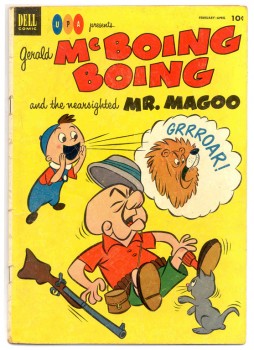 – There’s been a lot made about UPA these past few weeks because of the upcoming show in Hollywood at The Egyptian Theater (today). Rightly so, they did some great work in their early years.
– There’s been a lot made about UPA these past few weeks because of the upcoming show in Hollywood at The Egyptian Theater (today). Rightly so, they did some great work in their early years.
But we have to remember that once they reached their pinnacle during the early fifties, they sort of STOPPED and kept running in place. After teaching the world that 20th century graphics worked in animation – unlike the model set by Disney et. al. – they stopped in their Steinberg phase. Magoo kept puddle jumping, and after the first McBoing Boing, they broke little ground with the character.
It took till the late fifties for me to catch up to them, so I’m glad they ran in place for awhile. I loved Magoo’s Christmas Carol, regardless how limited its animation was. I even watched the Dick Tracy show as a kid and was happy that it looked different than Little Audrey and Popeye. But if we look seriously at the history of animation, we have to say that ART stopped happening at UPA after Unicorn In The Garden, The Telltale Heart and Madeline.
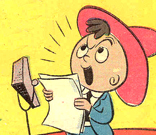 – Dave Hilberman and Zach Schwartz had left the studio because of a control issue in the studio. John Hubley eventually was forced out for fhis political beliefs and another attempt to control the studio.
– Dave Hilberman and Zach Schwartz had left the studio because of a control issue in the studio. John Hubley eventually was forced out for fhis political beliefs and another attempt to control the studio.
Hilberman and Schwartz started Tempo, a commercial production studio in NYC, in 1947 and continued working until McCarthyism hit and closed their studio. Hubley eventually started Storyboard, also to produce commercials. However, Hubley started work on Finian’s Rainbow, an animated feature that, from the look of the remaining art and soundtrack tapes, was certainly a push forward for the ART of animation. That, too, was ultimately killed by Joseph McCarthy’s attempt to destroy civil liberties.
 Hubley moved to NY and began working in the style of the new art, abstract expressionism. UPA continued turning out cartoons in the style that they been stuck in for the rest of their history. They no longer were moving the ART forward, but were exploiting their reputation for the commercial interests.
Hubley moved to NY and began working in the style of the new art, abstract expressionism. UPA continued turning out cartoons in the style that they been stuck in for the rest of their history. They no longer were moving the ART forward, but were exploiting their reputation for the commercial interests.
In their initial days, UPA was the studio that changed the world of animation. The films they did in those days are the ones celebrated at events like today’s. It’s wonderful that those films are still alive and being seen. It’s too bad the studio didn’t go further; maybe they’d still be around.
- Today’s NYDaily News has an article about animation features by lead resident critic, Jack Mathews. Talk about art!
Animation Artifacts &Comic Art &Hubley 25 Mar 2006 07:41 am
Letterman I, II, & III
Trying to recover some of the highlights from the past two weeks, I’m reposting these items from the Letterman series done for The Electric Company, starting back in 1972.
- These drawings are animation drawings of a run cycle done by Tissa David for the first season of the show.
There were three seasons of Letterman episodes we did at the Hubley Studio. All 60 episodes were 2 1/2 mins. apiece including the reused wrap-around: “It’s a bird! It’s a plan! It’s Letterman!” They were all directed by John Hubley. The first 40 episodes were all done in-house. The last 20 episodes were split with 10 done in the NY studio and 10 farmed out to Fred Wolf‘s studio in LA. The boards and layouts in NY for those sent out. Fred and Chuck Swenson animated all 10. (These are also the only episodes to use cel vinyl.) The audio was done in NY, and editing was done in the studio by Faith Hubley.
In the first season of the show the primary voices were: Gene Wilder as Letterman, Zero Mostel as Spellbinder, Joan Rivers as the Narrator, and Jack Gilford doing incidental voices. Billy Taylor did the music.
II
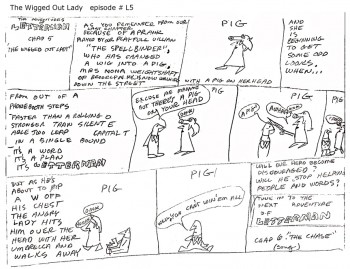 Christopher Cerf wrote all 60 episodes of Letterman, probably in collaboration with John Hubley. The storyboard posted here for episode #5 was by Chris Cerf; that’s pretty much how he did the scripts.
Christopher Cerf wrote all 60 episodes of Letterman, probably in collaboration with John Hubley. The storyboard posted here for episode #5 was by Chris Cerf; that’s pretty much how he did the scripts.
It’s undeniable that the wacky “naive” drawings undoubtedly inspired the models for the characters in the films.
(Click on any image to enlarge to a readable size.)
No doubt also affecting the models was an acccident that John Hubley had had at the start of production on this first series. At a dinner party, John tried to stop a falling 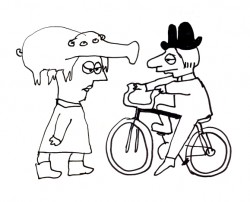 fondue pot filled with melted cheese. Horrible burns over both hands somewhat hampered his artwork. I would make several visits a day to his nearby apartment to have art approved. To have John draw, we’d prop a felt-tip pen into the mass of gauze and cotton and bandages wrapped around both hands. He’d move his wrapped fist around a sheet of paper and end up with a model like the one posted here. This went on for about three weeks (roughly half of the production time.) When he returned, backgrounds were done at a super speed.
fondue pot filled with melted cheese. Horrible burns over both hands somewhat hampered his artwork. I would make several visits a day to his nearby apartment to have art approved. To have John draw, we’d prop a felt-tip pen into the mass of gauze and cotton and bandages wrapped around both hands. He’d move his wrapped fist around a sheet of paper and end up with a model like the one posted here. This went on for about three weeks (roughly half of the production time.) When he returned, backgrounds were done at a super speed.
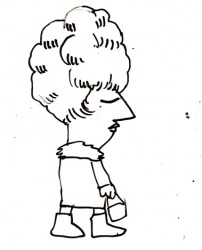
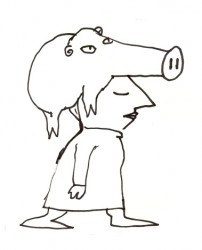 Everything was modeled on Krazy Kat. Lots of white space with sparkling color sprinkled about. The lines were dressed up with a ragged cross-hatching. The characters were colored with magic marker. (John’s favorite color was Eberhard Faber’s “Shock Pink”. Letterman’s skin color took this tone. It showed up in almost everything John did with markers.) The backgrounds were inked with a pentel felt-tip. John would throw a light wash of water over some of these lines to get them to bleed.
Everything was modeled on Krazy Kat. Lots of white space with sparkling color sprinkled about. The lines were dressed up with a ragged cross-hatching. The characters were colored with magic marker. (John’s favorite color was Eberhard Faber’s “Shock Pink”. Letterman’s skin color took this tone. It showed up in almost everything John did with markers.) The backgrounds were inked with a pentel felt-tip. John would throw a light wash of water over some of these lines to get them to bleed.
We’d race daily to get at least half a dozen scenes ink, painted and colored on paper. Then it’d be packaged and sent out via Fed Ex. (Celine Miles in LA cut & pasted the colored drawwings to cels; the art was shot at Animcam by Jack Buehre.) The FedEx guy arrived daily at 5:30pm, so that was my deadline. I found myself coming in at 7am to add more time to the day. I’d watch the clock which ticked furiously; I averaged 30secs to ink a drawing – any more, and I wouldn’t make Faith’s deadline.
III
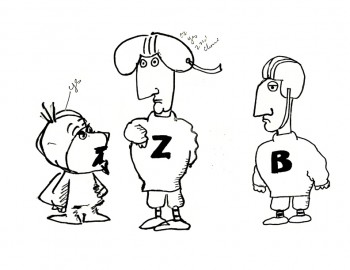 – These scrappy examples are not the best to give an indication of Letterman. But they were the ones I saved, so they’ll have to do. John Hubley drew these very early in the production, and they undoubtedly owe something to Chris Cerf‘s hilarious storyboards.
– These scrappy examples are not the best to give an indication of Letterman. But they were the ones I saved, so they’ll have to do. John Hubley drew these very early in the production, and they undoubtedly owe something to Chris Cerf‘s hilarious storyboards.
The animators involved in season one included: Tissa David, Johnny Gentilella, Vinnie Bell, Lu Guarnier and Jack Schnerk.
Helen Komar, a veteran Asst. Animator in NY, was the coordinator of the production and Gen Hirsch also colored. Gen and I got really close over the couple of years we worked together. She was the wife of Joseph Hirsch, the brilliant artist and mother of Paul Hirsch (editor of Star Wars and other incredible films) .
It was my first real job in an animation studio. Probably for this reason, I remember a lot of what happened – it was indelibly etched in my memory. I was the inker, colorist (we used markers, remember), animator of miscellaneous scenes (I think I animated some 40 scenes that first season), hole puncher, and Assistant Animator.
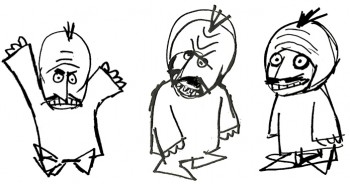 It was in the capacity as Assistant Animator that I found trouble. I hadn’t done it before, except for myself, so was horribly untrained. Because the schedule was so ridiculously tight, I had to assist in ink (Sharpie pens – the fat ones that dribbled ink and bled through multiple sheets of paper) and correctly put some of the animation – I won’t say on model, but closer to model.
It was in the capacity as Assistant Animator that I found trouble. I hadn’t done it before, except for myself, so was horribly untrained. Because the schedule was so ridiculously tight, I had to assist in ink (Sharpie pens – the fat ones that dribbled ink and bled through multiple sheets of paper) and correctly put some of the animation – I won’t say on model, but closer to model.
Johnny Gentilella, an absolutely wonderful guy, was the farthest astream. He was THE Popeye animator at Paramount. His characters looked like Paramount characters, and I had to get them closer to John’s style. This meant assisting (in ink), inbetweening and basically redrawing everything he’d done – in a rush – without proper training. The guilt of what I was doing to Johnny’s drawings weighed heavily on me, and I eventually apologized to him for what I’d done. He laughed and told me that he had no problem with it. This was standard for NY production in those days and he was used to it. (As a matter of fact, he hired me for another job he directed months later. So I guess he wasn’t too upset. I was.)
The race against the clock was always on; my career had started, and it couldn’t have been more fun. And I was working for John Hubley.
Animation Artifacts &Daily post 23 Mar 2006 08:07 am
It’s Official
- Well, it’s official. The last two weeks of this blog are gone for good, but my “Web Host” tells me they’re more efficient since upgrading their cables. For some reason, a number of links to my site on others seem to have broken. Thank you for your patience with this nonsense.
- There were three particular items that I want to repost since I thought them valuable. I know that’s unusal for a blog, but what the hell – this is a Splog.
I had posted some Letterman art, 3 pages of Pinocchio production drafts, and art from a couple of my films by Bridget Thorne. I’ll start today by putting up the Pinocchio drafts (which are at the end of this page.) I’ll use Saturday to post the Letterman material, and I’ll post Bridget’s art and backgrounds next week.
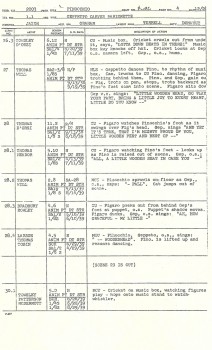
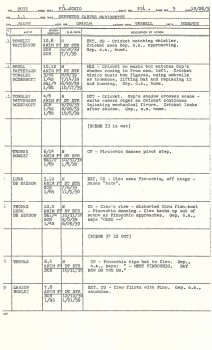
(Click on any item to enlarge.)
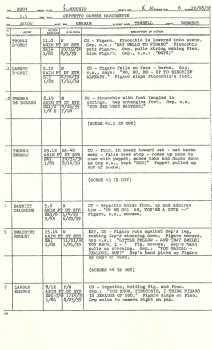 - These three pages of the Production Drafts for Pinocchio finish off the “Little Woodenhead” sequence and have Gepetto introducing the puppet to Figaro and Cleo.
- These three pages of the Production Drafts for Pinocchio finish off the “Little Woodenhead” sequence and have Gepetto introducing the puppet to Figaro and Cleo.
I have the sheets for this film through the Blue Fairy sequence and will post more of them next week.
- I’m still waiting for Disney to release a “Platinum” edition of Pinocchio. It’s arguably Disney’s best crafted film – certainly, it’s the highlight of the “Golden” era. It deserves extras up the kazoo. Unfortunately, these days the extras they offer from Disney don’t include the valuable commentary tracks of past DVDs. They offer games and puzzles for children. It’s sad for the collector to have to know what can be offered and accept what will be offered.
As I pointed out recently (lost to the archives) the Disney Rarities DVD is not the gem it should have been. Bad transfers, inadequate extras and no commentaries – other than the one for A Symposium On Popular Song by Richard Sherman which was added in a clumsy fashion making it pointless.
- Mark Kennedy has been posting some invaluable notes on color and composition by the late, Rowland Wilson. All you artists out there should take a look at these documents. I first met Rowland back at Phil Kimmelman‘s studio on “Conjunction Junction” for Schoolhouse Rock. Dick Williams then introduced him to me years later at Raggedy Ann & Andy. The guy was a consummate artist and a powerhouse of knowledge about his craft. You’ll have no doubt about it once you look at these notes.
Mark has a interesting, very informative site. I look forward to visiting it every day.
Animation Artifacts &UPA 22 Mar 2006 10:34 am
Root Toot 2
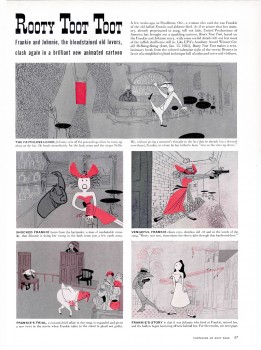
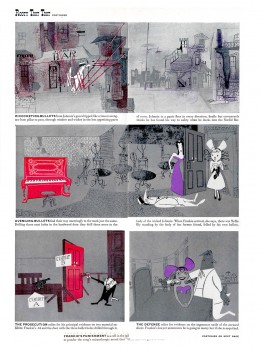
(Click any image to enlarge to a readable size.)
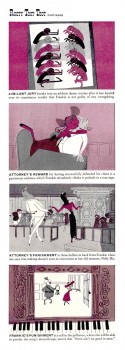 - This is my second attempt at posting this LIFE Magazine story on Rooty Toot Toot from a March, 1952 issue. They obviously enjoyed the UPA films back then, and luckily for us they posted it on something concrete – like paper.
- This is my second attempt at posting this LIFE Magazine story on Rooty Toot Toot from a March, 1952 issue. They obviously enjoyed the UPA films back then, and luckily for us they posted it on something concrete – like paper.
Next Sunday, March 26th there will be a UPA program to be held at the Egyptian Theater in Hollywood. The films scheduled include:
Bobe Cannon’s “Gerald McBoing-Boing”, John Hubley’s “Rooty Toot Toot”, Ted Parmelee’s “The Tell-Tale Heart” and Pete Burness’s “When Magoo Flew”, as well as shorts produced for “The Gerald McBoing-Boing Show”, “Deerfoot Dan” and “Blues Pattern”.
There will also be a preview of a forthcoming documentary THE BOING THAT SHOOK THE WORLD.
In between the films there will be two panels hosted by Jerry Beck. His guests will be: UPA animators and designers including Bill Melendez, Alan Zaslove, Willis Pyle, Fred Crippen, and Sam Clayberger. There will also be contemporary artists: Mark Kausler (BEAUTY AND THE BEAST, THE LION KING), Lou Romano (production designer of Pixar’s THE INCREDIBLES) and author/historian Amid Amidi.
It sounds like an amazing show that I only wish I could attend. I’ll have to satisfy myself with those amazing studio photos posted by Amid on the Cartoon Modern site.
Sunday, March 26 – 6:00 PM
The Egyptian Theater
6712 Hollywood Boulevard
Hollywood, CA 90028
Animation Artifacts &UPA 22 Mar 2006 07:24 am
Rooty Toot . . .
Where did I leave off ?
On Monday, a couple of hours after I posted a story about Rooty Toot Toot, my site went down and took the SPLOG with it. It’s been a tough couple of days trying to deal with the “upgrade” of my Web Host. They got the site back yesterday, and it’s taken till now to get this much of my blog back. (I guess I was given a “downgrade.”) It looks like my last two weeks worth of material has disappeared into their database . . . or maybe it’ll show up in a couple of hours. Who knows? (You can’t trust computers, these danged things!)
As soon as I get my “Image Browser” back, I’ll reconstruct last Monday’s UPA posting and try to go on from there. If the last two weeks were lost, I’ll try to recover some of what I posted this coming weekend.
In the meantime, on a lighter note, there’s a funny bit about a custody battle in Sweden fighting over a Donald Duck comic book. Go to the end of today’s “Arts, Briefly ” NYTimes article.
